Let’s say you have a target of bringing 4x revenue this year.
What will you do first?
Well, generate leads and build a pipeline.
After that?
You’d want to prioritize leads that are more interested in buying your products or services.
But how would you do that?
Our answer is— by lead scoring.
Let’s dive deeper into:
- What is lead scoring?
- The importance of scoring leads
- Popular lead scoring methods
- Helpful tools
- Setting up your system for lead scoring
- Success stories
What is lead scoring?
Lead scoring is a method of assigning numeric values to the leads based on their behavior related to their interest in a company’s products or services. It is the way of qualifying leads commonly used by sales and marketing teams.
For example, a lead that has signed up for a newsletter subscription gets a lower lead score than the lead that has signed up for a free trial or product demo.
You may wonder why you should put effort into evaluating leads rather than generating more leads.
Let me answer that.
The importance of lead scoring
“Organizations that use lead scoring experience a 77% lift in lead generation ROI, over organizations that do not use lead scoring.”
Marketing Sherpa
You don’t always know a good lead when you see one. Too often, it takes hours of conversations and emails only to find out that you’re wasting your time. While you don’t want to miss out on a good lead, you also don’t want to spend time unnecessarily on leads that will never close.
By scoring leads, you can realize the following benefits:
1. Identify the sales readiness of your leads and prioritize sales activities
Without any identifiers on lead quality, your SDRs will probably call each lead on a first-come-first-serve basis. The result—the one that’s more interested in your product/service will be called only when there’s their turn.
However, had your reps known the “hot leads,” they would have called them first. Lead scoring helps identify leads that match your customer profile and prioritize sales activities accordingly.
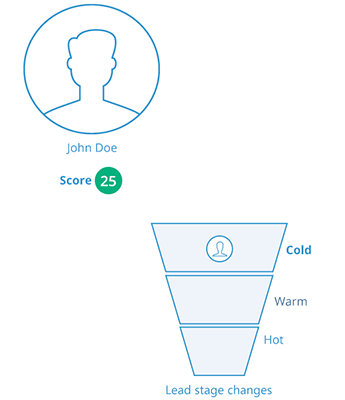
2. Identify up-sell/repeat sale opportunities from existing customers
Through engagement scoring, you can identify up-selling and cross-selling opportunities with your existing customers.
How?
Let’s see.
If you suddenly see that a 1-year-old customer has suddenly started accumulating engagement scores again, in all probability, they want to buy again and are looking for options. An email or a call from sales at this point would result in a quick closure.
“The odds of contacting a lead if called in 5 minutes are 100 times higher versus 30 minutes. The odds of qualifying a lead if called in 5 minutes are 21 times higher versus 30 minutes.”
(via Forbes)
3. Help marketers segment and target leads accordingly
Lead and Engagement Scoring can help marketers identify different brackets of engagement and create customized offers to push your raw opportunities to conversion. What’s even more interesting is that they would be able to identify the lead sources that get the most closures and advise you to allocate your marketing budgets accordingly.
For instance, say your marketing ninja John has identified Facebook as the source from where the engagement scores have recently been higher. Therefore, you can put more money into Facebook.
4. Align your sales and marketing teams
Sales and marketing must work together to ensure the right leads enter the pipeline. Having data-driven proof of lead quality can help marketers better understand who they’re attracting for the sales team, what the high-scoring leads have in common, and where adjustments need to be made to continue attracting better leads.
5. Make data-driven decisions
The entire scoring mechanism allows you to identify the percentage of engaged prospects at any given point. It thus helps you to devise strategies to increase engagement.
You can look into your existing data and identify what kind of offers have driven higher engagement in the past (like a survey/contest) and run a similar once again to reactivate your disengaged leads.
Finally, lead scoring and engagement scoring can also help you understand your audiences’ interests in your products or services. That is, by looking at the scores, you can identify popular products.
So, these are some of the evident benefits of lead scoring. Let’s look at the methods of lead scoring you can adopt.
Lead scoring methods
Companies generally score leads based on demographic, firmographic, and behavioral data. Below are some of the most popular methods of lead scoring.
- Engagement scoring
- Demographic lead scoring
- Predictive lead scoring
- Rule-based lead scoring
Engagement scoring
Engagement scoring is an advanced form of lead scoring that considers the recency of your engagement activities in addition to the lead score.
The engagement score is calculated based only on engaging activities and a timeline that you specify.
Let’s say you want to find out leads that are most engaged with your sales and marketing communications in the last 30 days.
Here, a lead that interacted with you last year will not be considered even if their score is higher.
“We use engagement scoring to automate our nurturing campaigns. Leads are nurtured with email campaigns over a definite period, and once the engagement score crosses the threshold, we pass them on to the sales team. Since engagement score is calculated for a specific period, we ensure we don’t pass cold leads to sales reps.”
Hiral Shah, Senior Manager – Growth Marketing, LeadSquared
How does engagement scoring work?
In this technique, you assign different scores to the types of interactions a lead or a customer can have with your brand.
For instance, if they are very active on your website and visit pages like your Product features, Pricing, etc., they would score higher on your relevance sheet.
However, if they are active on your website but visiting pages like Career Options, Work Culture, etc., then they sure are interested in your business but not as a prospective buyer. So visits to these pages should have a lower score to bring them off your sales radar.
All businesses are different, so there is no set formula for the kind of activities you would rate, but some things are a given. Any activity that gets a lead closer to closure in your sales cycle is a positive lead activity and anything that gets them away from your business is a negative lead activity.
You would typically assign scores based on:
1. The importance marketing and sales assign to an activity.
2. How an activity contributes to taking the lead forward and backward in the sales process.
3. Experience and anecdotal data. Look at your database, talk to your sales and marketing people, and identify which activities push the leads down the sales funnel.
Let’s take a few activities as examples:
Marketing Related Activities
a) Newsletter subscription form filled = +2
b) Product Inquiry form filled = +20
c) Unsubscribe or email bounce = -50
Sales Related Activities
a) Salesperson had an awesome conversation = +30
b) The prospect said not interested to buy your product or service = -100
As you can see, I have assigned scores based on the importance of the respective activities to the sales cycle. Even though a newsletter subscription is a positive activity, it doesn’t say much about whether or not the lead is interested in spending money with you. Therefore, the score assigned is comparatively less. On the other hand, an awesome sales conversation is a definite positive in the direction of sales closure, so a higher score has been assigned to that.

Demographic lead scoring
In this method, you qualify leads based on their demographic information. It is also referred to as lead quality scoring as it helps you identify the quality of leads that enter your sales pipeline.
For example, let’s say you own a car dealership in Denver. So, your target customers would be 25 to 70 years old people and those who live in Denver and nearby cities. Now, if you have a website, people from across the world can access it and drop queries.
Demographic lead scoring helps you segregate inquiries that you can serve.
Here, you assign scores based on a prospect’s demographic info such as age, gender, location, income group, past purchase with your brand, and more.
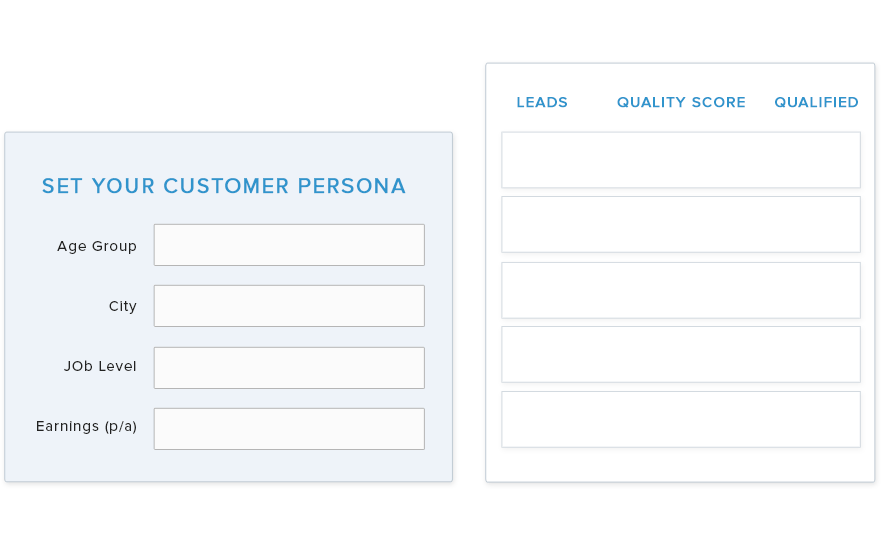
Predictive lead scoring
Predictive lead scoring is a framework that uses an algorithm to analyze historical data within your CRM and tells you which accounts/leads are most likely to convert. Important attributes are automatically chosen based on common factors derived from deals that were won and lost. It basically identifies trends and patterns from the past and generates a prediction for the future.
How does predictive lead scoring help?
Even the most experienced sales and marketing teams are perplexed with identifying the factors that helped close a deal. Undoubtedly, they can summarize the events that led to the closure. But naming every element that contributed to attracting a prospect’s interest is a tough job. When done manually, it just elevates the possibility of manual error.
Predictive lead scoring will help you name these parameters by scrutinizing past deals. Since the entire process is automatic, you can ensure both reliability and accuracy. It will help you take a targeted approach and enable you to use customer intelligence to your benefit.
Pros and cons:
While it can work wonders after implementation, the process requires a huge chunk of data to be able to make a proper analysis. A small sample set wouldn’t do much justice. Hence, businesses that have just started or those which don’t have a huge database may not benefit from this.
One more pre-requisite would be to clearly mark accounts with tags (won/lost or customer/prospect etc.) so that the algorithm can effectively analyze all kinds of data and provide the optimum results to produce more sales-ready opportunities for your team.
Rule-based lead scoring
Contrary to predictive scoring, rule-based scoring works on a set of predefined rules.
In other words, predictive lead scoring works on an algorithm. Whereas in rule-based lead scoring, you set up your lead scoring workflow manually. Here’s how it works.
Let’s say you have created a landing page for downloading an ebook. You would aim to capture leads. Now, while creating the landing page, you can define backend actions, such as:
- Send an automated email with the ebook pdf link
- Add leads to a particular list
- Increase lead score by X
The users will not notice this, but you can observe the change in lead scores basis such activities in your CRM software.
You can use either or all of the above methods of lead scoring. Using only one method is called one-dimensional lead scoring. But if you use more than one method of lead scoring, you’d be using multi-dimensional lead scoring.
It is recommended to use a multi-dimensional lead scoring mechanism because it takes into account the recency and frequency of activities. Instances like leads switching jobs, changing phone numbers, etc., are common. If you rely on only one method, you might end up strangled in obsolete data.
“1-dimensional lead scores are a good place to start, but don’t confine yourself to a single numeric score. Using multiple dimensions for lead scoring will provide you with a clearer picture of your lead portfolio which in turn will lead to more effective marketing and sales.”
Colin Hung, Marketing Executive (via HITMC)
Lead scoring tools
In most cases, companies use CRM software for lead scoring purposes as well. It’s fair also because the CRM already has the data you need for this purpose.
Some of the best lead scoring CRMs available in the market are:
- LeadSquared: Supports quality scoring, engagement scoring, and lead scoring
- HubSpot: Supports predictive lead scoring
- Zoho: multichannel lead scoring
- Salesforce Essentials: Supports third-party lead scoring integrations
- ActiveCampaign: Suitable for lead scoring based on email campaigns
Apart from these, you’ll also find specialized tools for lead scoring. Some of the best ones are:
- Slintel: Utilizes data to analyze buyer journeys, technology adoption patterns, and more
- Infer by Ingnitetech: Best for predictive lead scoring and profile management
- Madkudu: Uses data science-based models for lead prioritization
- Breadcrumbs: Scoring based on recency and frequency of engagement
- SalesPanel: A specialized tool for lead qualification
The only drawback of using specialized tools is that they don’t have data of their own. You’ll have to integrate your CRM with these tools to get the insights. That said, these tools are great at what they do.
If you use a CRM that supports lead scoring functionality, we can help you set it up. Read on to the next section.
How to set up your CRM for lead scoring
As mentioned before, CRM software like LeadSquared provides three lead scoring mechanisms:
- Quality scoring
- Lead scoring
- Engagement scoring
You can utilize information from your customer profile to calculate the quality score. In this, you assign values to lead attributes like job title, company size, product interested in, and more.
Lead scoring and engagement scoring consider lead activities. However, they both differ in a way that leads score can be calculated for an infinite amount of time, whereas you define a specific period for engagement scoring.
Let’s look at how you can set it up in a CRM.
Step 1: Set up the criteria:
- Define the activity period. For this, your need to know your sales cycle duration. You can take this step further if you know how much time a prospect spends on a particular stage. Use this info to create engagement campaigns according to the stage of prospects in your sales funnel.
- Determine the lead stages you wish to include. You might not want to calculate the lead score for your customers. Since both lead and customer records are stored in your lead management CRM, it’s better to specify the lead stages in consideration.
- List down the activities you wish to include for calculating the lead score.
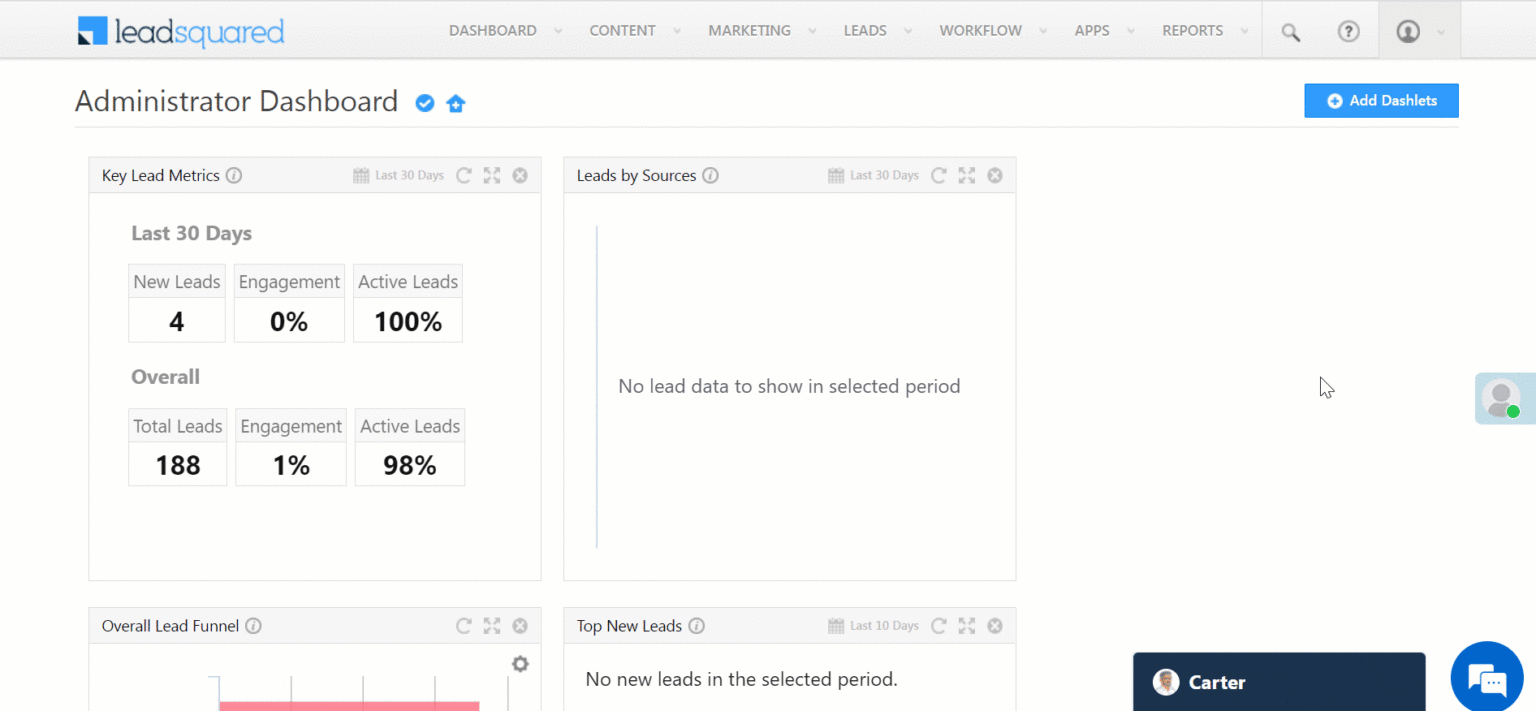
Step 2: Assign scores
Here, sales and marketing alignment is crucial.
If you’re a marketer setting up the system for lead scoring, consult your sales department about activities they check to understand the buyer’s intent.
On the other hand, if you’re a sales manager defining the lead scores, consult your marketing team once. It is because marketers give different weightage to different marketing activities. For example, in general, a lead captured through a PPC ad has more buying intent than the one who is exploring different systems through organic search.
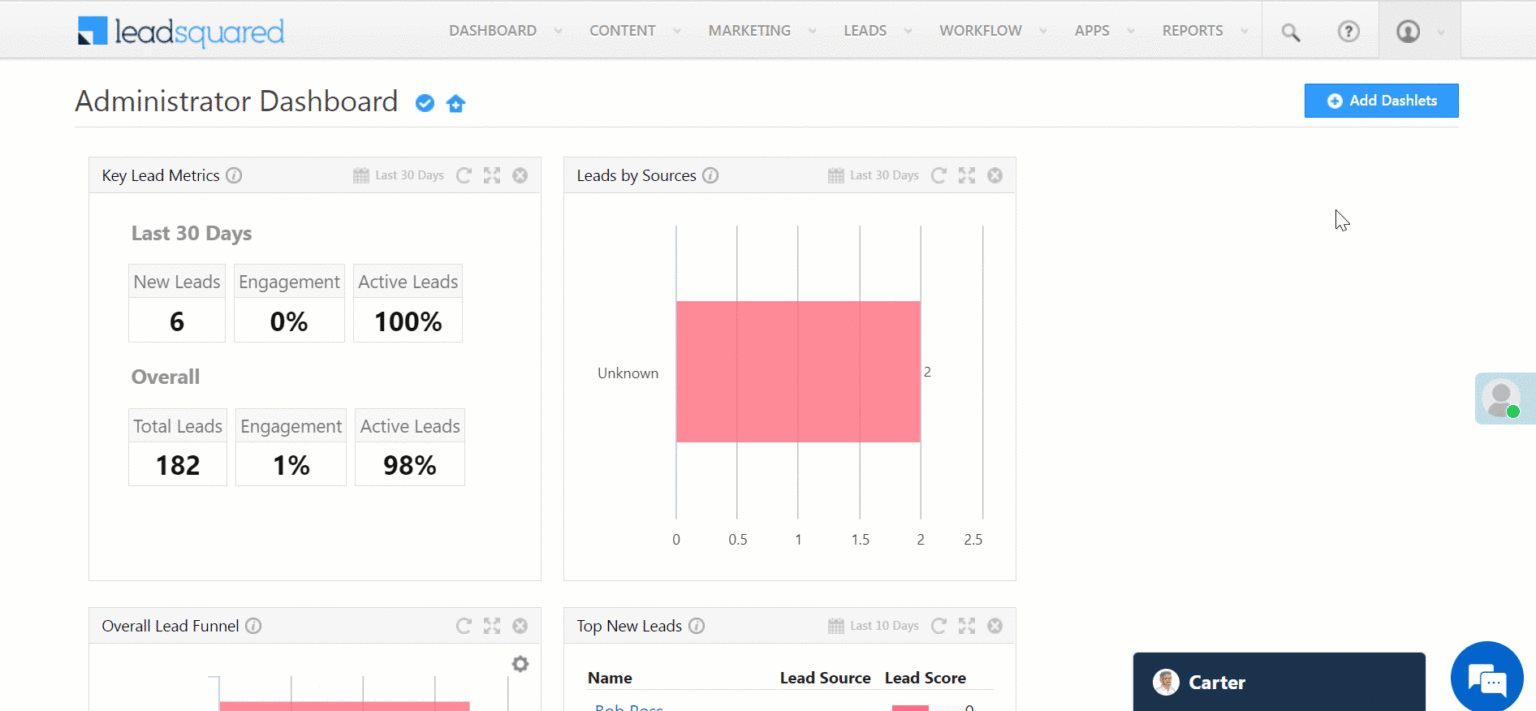
Step 3: Define a threshold
After a few closures in your new scoring framework, you would be able to identify the average score after which the leads are sales-ready. One of our clients from the real-estate sector shared that when a lead crosses a score of 200, it is ready for a serious sales conversation.
Step 4: Set up a lead distribution mechanism
The distribution logic completely depends on your sales process. However, you may also utilize the lead score to map leads to agents/sales reps. For instance, you may want to assign hot leads to your top reps.
“Lead and engagement scoring help us prioritize leads and distribute leads among our agents.”
Siddharth Gupta, Associate Director – Growth, Uni
Step 5: Run reactivation campaigns
Leads that show no activity for a long time are regarded as cold leads. Generally, such leads have a lower lead score. You can run targeted engagement campaigns to reactivate them.
One of our insurance clients utilized a lead scoring mechanism to reactivate their cold leads. And to everyone’s surprise, over a thousand leads engaged and entered the buying funnel.
You can read the complete story: A simple hack to reactivate dead leads
This isn’t a one-off. In the next section, we’d like to tell another story of how lead scoring helped a leading FinTech brand achieve its sales goals.
[Case study] How lead scoring helped Uni Cards onboard 4x customers
Uni is a new-age FinTech aimed at revolutionizing the B2C credit space in India. In the beginning, they used excel sheets for sales and customer onboarding. However, as the business grew, it became difficult for them to track the stages the leads are in. It resulted in chaos between the internal team members and several lost opportunities.
The lead scoring mechanism was a part of the solution LeadSquared provided Uni to manage their sales process.
They used lead and engagement scoring to prioritize high-intent leads. Further, they automated the lead distribution workflow, where high-priority leads were distributed to agents for follow-ups.
The entire solution resulted in 4X growth in terms of customers and increased sales efficiency.
Read the complete story of Uni’s journey of streamlining the sales and collections pipeline.
If you want to try software that suffices all your sales and marketing leads along with lead scoring, give LeadSquared a try. Our team is all ears to understand your requirements and propose an appropriate solution. Book a demo to consult with them.
FAQs
LeadSquared’s CRM software allows you to calculate lead scores of offline leads.
All you need to do is create a custom activity beforehand. Let’s say you created an activity—Event attended—and assigned it a score of 50. After the event, once you add the event attended activity to the leads that showed up for the event, the lead score will be automatically updated. This can also be done in bulk.
You can send them offers that are relevant to them, depending on the pages that they have viewed, etc. And if they are engaging with that, they might become more relevant for the sales call.
Lead scoring helps you decide how to take forward the sales interactions with prospects, and it is definitely relevant for B2B and B2C businesses. We are a B2B business, and we have been using lead scoring for qualification and prioritization. Our B2C customers like Uni use it for distributing leads to agents.







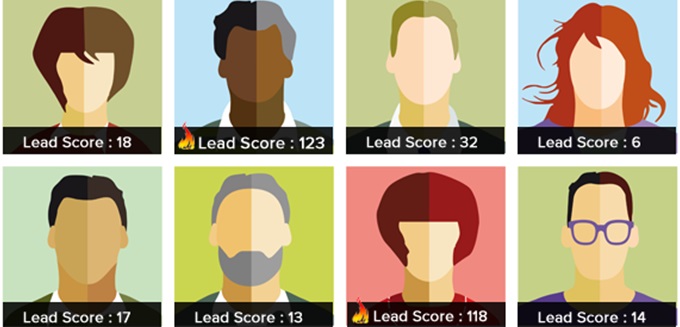


![[Webinar] Sales Automation 101: Unclog your Sales Pipeline](https://www.leadsquared.com/wp-content/uploads/2024/04/automation-webianr-popup.gif)
